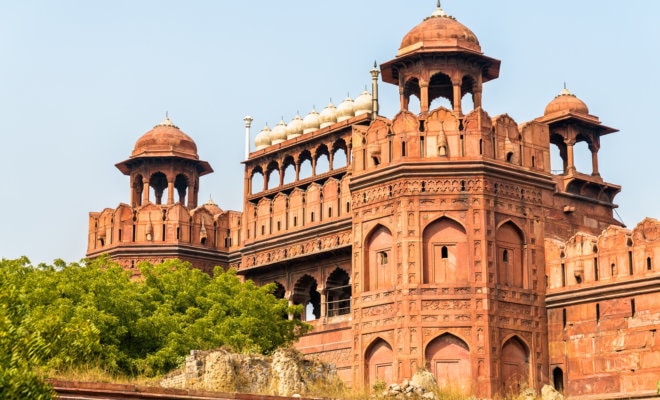Arts
Corporate Takeover of India’s Iconic Red Fort Leaves Historians Alarmed

The iconic Red Fort in the center of New Delhi has been “adopted” by Indian conglomerate Dalmia Bharat Group, sparking fresh outrage over the government’s mishandling of India’s centuries-old heritage.
As part of a $3.7 million deal, Dalmia will be responsible for keeping the 17th century fort clean and maintaining tourist infrastructure such as signs, toilets and lights for the next five years. A clause in the agreement says that the company can’t profit directly from the deal by charging tourists, but Dalmia’s name will appear on signs – giving the company prominence at one of India’s most visited tourist sites.
Conservationists and historians have said that handing over the responsibility for such an important monument – once the residence of India’s long reigning Mughal rulers and the political center of their empire – could cause irreparable damage to the country’s historical treasures.
Historian and writer William Dalrymple said the government was treating the Red Fort as a “guinea pig.”
“It seems to me that monuments like the Lincoln [Memorial], Stonehenge, or the Taj Mahal – monuments that represent the nation should be the preserve of the state,” he said. “It’s one thing to have a McDonalds stadium or a McDonalds minor fortress, but to have the Red Fort, that represents the nation, being adopted by a company, is inappropriate,” he said.
The Red Fort looms large in India’s modern history, with the country’s first prime minister, Jawaharlal Nehru, raising the nation’s new tricolor flag over its main gate on the day India gained independence from Britain. Since then, every year the prime minister delivers a speech from its ramparts on Independence Day.
In an opinion piece in Indian media this week, one historian pointed out that the memorandum of understanding signed by the government absolves the company of responsibility should any damage happen to the monument. Another noted that Dalmia has no previous track record in maintaining historical sites and that the time frame allocated for certain activities such as “restoration and landscaping” – which is supposed to happen in less than a year – was “disturbingly swift.”
The move is part of the government’s attempt to defray the costs of maintaining India’s extensive historical heritage through an “Adopt a Heritage” program that invites the private sector to “adopt” various monuments. The Red Fort is the first of more than 93 tourist attractions to be given up for adoption and the government has said it has no intention of turning back.
“It is an executive decision taken by the government to sign the MoU [memorandum of understanding]. No changes to the present project will be done. We will only expand the project to include more such sites and monuments,” Tourism Minister K. J. Alphons said speaking to the Press Trust of India.
The country is home to thousands of ancient structures – many of which have been poorly maintained, lost or degraded over time.
The Red Fort won’t be the first iconic building to go under the care of a private organization. Palaces in the western state of Rajasthan have been bought by hotel chains, while New Delhi’s Humayun’s Tomb is looked after by a non-profit, the Aga Khan foundation – which, however, has a long and distinguished history of conserving and maintaining Muslim historical sites.
Dalmia, however, has little experience handling historical sites – particularly Muslim ones. Dalrymple pointed out that Vishnu Hari Dalmia, a senior member of the Dalmia family, is one of the co-accused in the controversial Babri Masjid demolition case, in which Hindus destroyed a 16th century Mughal mosque that they believed was built on the site of the birthplace of the Hindu god Ram. “A corporation which has no prior record of conservation and whose patriarch is linked to the destruction of another Mughal monument, the Babri Masjid, seems a worrying custodian,” he said.
The Mughals were a Muslim dynasty that ruled northern India from the 16th century until the coming of the British in the 1800s and left a legacy of stunning monuments, including tourist-favorite, the Taj Mahal. The care of these monuments has become increasingly politicized under Prime Minister Narendra Modi’s Hindu nationalist government. One of his party’s prominent members, Yogi Adityanath, reportedly said the Taj Mahal “does not reflect Indian culture” and he had its pictures removed from tourist brochures of Uttar Pradesh, the state he governs. Chapters on Mughal history have also been wiped from textbooks in some states.
On Tuesday, India’s Supreme Court expressed concern over the deteriorating state of the Taj Mahal’s once glowing white marble, which has slowly been stained yellow and now brown by air pollution. The court criticized ongoing restoration efforts for not being sufficient and suggested outside experts be contacted.
“We don’t know whether you have or perhaps don’t have the expertise. Even if you have the expertise, you are not utilizing it. Or perhaps you don’t care,” the court said in a statement. “Perhaps we need some expert organization from outside India unless there is a decision that the Taj has to go.”
(c) 2018, The Washington Post

You must be logged in to post a comment Login